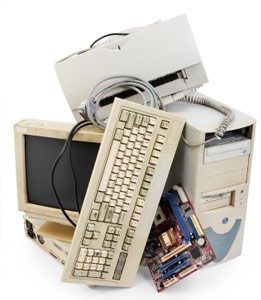E-Waste Recycling
E-waste is discarded electrical and electronic equipment. It is one of the fastest growing types of waste produced in both developed and developing countries. According to the UN’s Global E-waste Monitor report, e-waste has increased 21% in the past 5 years. In 2019, the world produced 53.6 million tons of e-waste, i.e. 7.3 kg per capita. Canada generated 757,000 tons of e-waste, i.e. 20.2 kg per capita.
E-waste contains hazardous metals, such as lead, cadmium, mercury, chromium and ozone-depleting chlorofluorocarbons, which contaminate soil, air, water and pose a threat to human health. Recycling e-waste can divert these hazardous materials from landfills and incinerators. Valuable materials in e-waste, such as iron, copper, gold, silver and aluminum, can also be extracted and reused to make new products. This reduces the demand for extracting new resources and thus avoids energy use and greenhouse gas emissions.
It is estimated that less than one-sixth of the e-waste produced has been recycled in an environmentally sound manner or made available for reuse.
So how can you help?
If you have spare electronic items like computers, monitors, TVs, and cell phones at home that you don’t need, first consider donating them to the others in need in the community. If they are broken, try fixing them rather than buying new ones. If your electronics are obsolete and you would like to dispose of them, make sure they are recycled properly.
As part of our Zero Waste Initiative, Sheridan supports the recycling of obsolete e-waste. In 2018, Sheridan diverted almost 6,928 kg of recyclable waste from going to landfills through the use of the e-waste recycling program on campus. Recycling e-waste can bring multiple benefits to all of us. Valuable resources and energy are conserved, the surroundings are protected, landfill spaces are saved, and jobs are created.
How do you recycle e-waste on campus?
What should you do when a broken keyboard or an old computer monitor in your office needs to be disposed of? How about used batteries and old cables in your laboratory or shop? Where should they go?
The technologist in your faculty/department or you yourself can drop them off at the e-waste collection bin located at Shipping/Receiving in your campus. Remember any disposal of electronic assets will need approval from your manager. Some of the e-waste items you may need to dispose of are what we call “capital equipment”. Each of these items is identified by a capital asset tag attached to the item. Please submit to Finance Department a Capital Asset Disposal Form that can be downloaded from the Access Sheridan site.
The e-waste collection bin at Shipping and Receiving generally receives small quantities of e-waste. To arrange for large amounts of e-waste for recycling, please contact the Office for Sustainability at missionzero@sheridancollege.ca.
What types of items are accepted for recycling? Below is the list.
Computers and Network Equipment
– Desktop computers
– Laptops
– Monitors
– Servers, routers, switches and modems
– Typewriters
Printers
– All printers, laser or inkjet
– Fax machines
– Scanners
– Photocopiers of any size
– Plotters
– Toner cartridges
Telephones and Cell Phones
– Landline and office telephones
– Cell Phones
– Office Telephone Systems
– Answering Machines
Audio and Video Equipment
– Stereos, radios, amplifiers and speakers
– Cameras and camcorders
– DVD players, VHS players and satellite receivers
Televisions
Batteries
Wires and Cables
Others, e.g. CD discs, disc plastic cases, etc.
If you have any questions regarding Sheridan’s e-waste recycling program, please feel free to contact us at MissionZero@SheridanCollege.ca.





Follow Us!